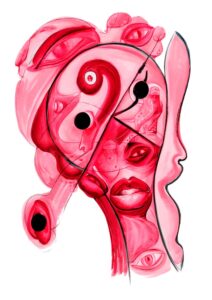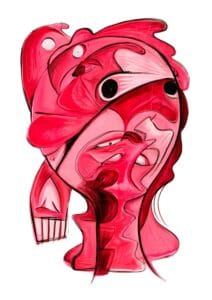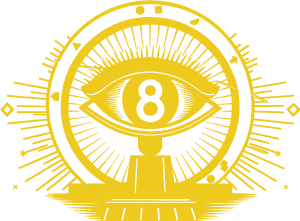
Jack Myntan’s Thoughtrait process represents a ground breaking fusion of art, psychology, and quantum theory, offering a unique window into the human psyche. This innovative technique builds upon a rich history of psychological exploration and artistic experimentation, while pushing the boundaries of what’s possible in portraiture.
the human psyche. This innovative technique builds upon a rich history of psychological exploration and artistic experimentation, while pushing the boundaries of what’s possible in portraiture.
At its core, the Thoughtrait process is an attempt to render visible the invisible landscapes of the mind. Drawing inspiration from Carl Jung’s work on the collective unconscious and the surrealists’ exploration of automatism, Thoughtraits aim to bypass the conscious mind and tap directly into the wellspring of unconscious thought and emotion.
The process begins with a carefully crafted environment designed to induce a state of relaxed alertness in both the artist and the sitter. Subtle aromatherapy and precisely calibrated sound frequencies help to quiet the analytical mind and open channels to deeper levels of awareness. This preparatory phase is crucial, as it sets the stage for the profound connection that follows.
As the Thoughtrait session unfolds, Myntan employs a series of techniques rooted in both traditional psychoanalysis and avant-garde art practices. A word association test, reminiscent of Jung’s pioneering work, serves as a verbal key to unlock the sitter’s unconscious associations. This is seamlessly integrated with elements of automatic drawing, a technique championed by surrealists like André Breton and André Masson as a means of expressing unfiltered thought.
What sets Thoughtraits apart is their synthesis of these established methods with cutting-edge concepts from quantum physics. Myntan posits that during the creation of a Thoughtrait, the minds of the artist and sitter become entangled on a quantum level, much like paired particles that remain connected regardless of distance. This entanglement allows for a profound meeting of consciousness’s, resulting in a visual representation that is neither solely the product of the artist nor the sitter, but a unique collaboration of two intertwined psyches.
The physical act of creating a Thoughtrait is a mesmerizing dance of intuition and technique. Myntan works rapidly, allowing his hand to move across the canvas with minimal conscious intervention. Layers of color and form emerge, often starting with a base of Alizarin crimson – a color choice that Myntan believes resonates with the fundamental energies of the psyche. The resulting image is invariably abstract, yet viewers often report sensing an uncanny emotional resonance or recognizing fragments of their inner landscape within the swirling forms.
 It’s important to note that while Myntan’sThoughtraits share some common ground with more familiar psychological tools like the Rorschach inkblot test, they differ significantly in both purpose and execution. Where inkblot tests present standardized images for interpretation, each Thoughtrait is a unique, co-created artefact of a specific moment in consciousness. They are not meant to be decoded or analysed in a clinical sense, but rather experienced as a direct encounter with the fluid, often contradictory nature of the unconscious mind.
It’s important to note that while Myntan’sThoughtraits share some common ground with more familiar psychological tools like the Rorschach inkblot test, they differ significantly in both purpose and execution. Where inkblot tests present standardized images for interpretation, each Thoughtrait is a unique, co-created artefact of a specific moment in consciousness. They are not meant to be decoded or analysed in a clinical sense, but rather experienced as a direct encounter with the fluid, often contradictory nature of the unconscious mind.
The Thoughtrait process has potential implications beyond art. Researchers in psychology and consciousness studies may become interested in this work. Thoughtraits could offer insights into perception, memory, and identity formation. They might also serve as a therapeutic tool, allowing individuals to externalize aspects of their psyche. However, these ideas remain speculative, as no research in this direction has been conducted yet.
As our understanding of consciousness continues to evolve, techniques like the Thoughtrait process stand at the forefront of exploration. By bridging the gap between art and science, between the measurable and the ineffable, Thoughtraits offer a tantalising glimpse into the vast, uncharted territories of the human mind. They challenge us to reconsider our notions of self, of reality, and of the intricate web of connections that bind us all.
In an age increasingly dominated by digital representations and artificial intelligences, Thoughtraits remind us of the profound mysteries that still lie within our own consciousness. They are not mere portraits, but portals – inviting us on a journey of self-discovery that is at once deeply personal and universally human.


